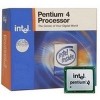Intel BX80532PG3200D Data Sheet - Page 62
Table 12., Signal Description, Sheet 4 of 8, Description, Signals, Associated Strobe
 |
View all Intel BX80532PG3200D manuals
Add to My Manuals
Save this manual to your list of manuals |
Page 62 highlights
Package Mechanical Specifications and Pin Information Table 12. Signal Description (Sheet 4 of 8) Name Type Description Data strobe used to latch in D[63:0]#. DSTBP[3:0]# FERR#/PBE# GTLREF HIT# HITM# IERR# IGNNE# Input/ Output Signals Associated Strobe D[15:0]#, DINV[0]# D[31:16]#, DINV[1]# D[47:32]#, DINV[2]# D[63:48]#, DINV[3]# DSTBP[0]# DSTBP[1]# DSTBP[2]# DSTBP[3]# Output Input Input/ Output Input/ Output Output Input FERR# (Floating-point Error)/PBE# (Pending Break Event) is a multiplexed signal and its meaning is qualified with STPCLK#. When STPCLK# is not asserted, FERR#/PBE# indicates a floating point when the processor detects an unmasked floating-point error. FERR# is similar to the ERROR# signal on the Intel® 387 coprocessor, and is included for compatibility with systems using Microsoft MS-DOS*-type floating-point error reporting. When STPCLK# is asserted, an assertion of FERR#/PBE# indicates that the processor has a pending break event waiting for service. The assertion of FERR#/PBE# indicates that the processor should be returned to the Normal state. When FERR#/PBE# is asserted, indicating a break event, it will remain asserted until STPCLK# is deasserted. Assertion of PREQ# when STPCLK# is active will also cause an FERR# break event. For additional information on the pending break event functionality, including identification of support of the feature and enable/disable information, refer to Volumes 3A and 3B of the Intel® 64 and IA-32 Architectures Software Developer's Manuals and the Intel® Processor Identification and CPUID Instruction application note. GTLREF determines the signal reference level for AGTL+ input pins. GTLREF should be set at 2/3 VCCP. GTLREF is used by the AGTL+ receivers to determine if a signal is a logical 0 or logical 1. HIT# (Snoop Hit) and HITM# (Hit Modified) convey transaction snoop operation results. Either FSB agent may assert both HIT# and HITM# together to indicate that it requires a snoop stall that can be continued by reasserting HIT# and HITM# together. IERR# (Internal Error) is asserted by the processor as the result of an internal error. Assertion of IERR# is usually accompanied by a SHUTDOWN transaction on the FSB. This transaction may optionally be converted to an external error signal (e.g., NMI) by system core logic. The processor will keep IERR# asserted until the assertion of RESET#, BINIT#, or INIT#. IGNNE# (Ignore Numeric Error) is asserted to force the processor to ignore a numeric error and continue to execute non-control floating-point instructions. If IGNNE# is deasserted, the processor generates an exception on a non-control floating-point instruction if a previous floating-point instruction caused an error. IGNNE# has no effect when the NE bit in control register 0 (CR0) is set. IGNNE# is an asynchronous signal. However, to ensure recognition of this signal following an input/output write instruction, it must be valid along with the TRDY# assertion of the corresponding input/ output Write bus transaction. 62 Datasheet















